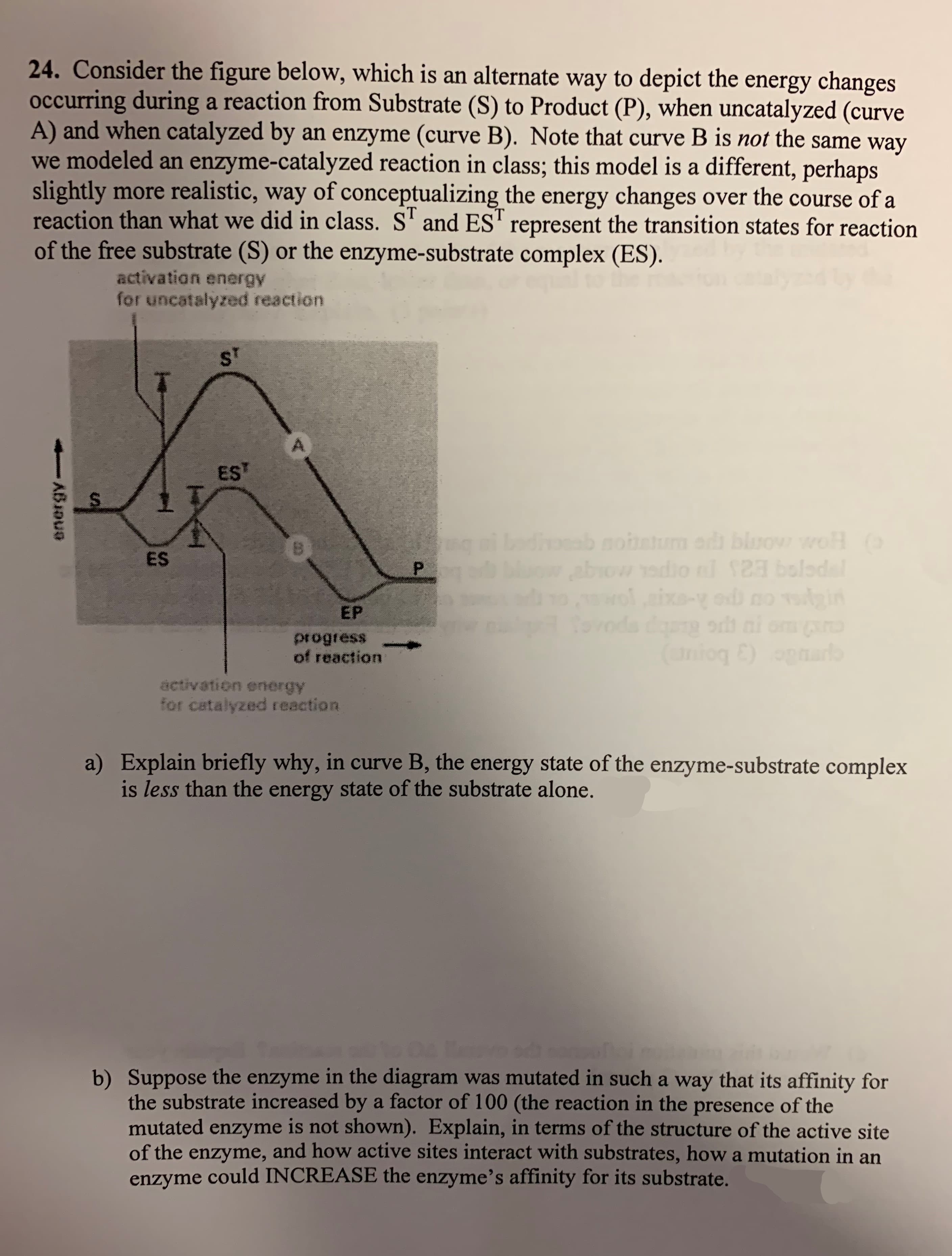24. Consider the figure below, which is an alternate way to depict the energy changes occurring during a reaction from Substrate (S) to Product (P), when uncatalyzed (curve A) and when catalyzed by an enzyme (curve B). Note that curve B is not the same way we modeled an enzyme-catalyzed reaction in class; this model is a different, perhaps slightly more realistic, way of conceptualizing the energy changes over the course of a reaction than what we did in class. S and ES represent the transition states for reaction of the free substrate (S) or the enzyme-substrate complex (ES). T T activation energy for uncatalyzed reaction EST S edhosob nohtum od bluo woH abiow yedio 2 wwolaixa-y odi no vaigin oroda dapng odt ni o nfog) r gibadhoa P B ES EP progress of reaction activation energy for catalyzed reaction a) Explain briefly why, in curve B, the energy state of the enzyme-substrate complex is less than the energy state of the substrate alone. b) Suppose the enzyme in the diagram was mutated in such a way that its affinity for the substrate increased by a factor of 100 (the reaction in the presence of the mutated enzyme is not shown). Explain, in terms of the structure of the active site of the enzyme, and how active sites interact with substrates, how a mutation in an enzyme could INCREASE the enzyme's affinity for its substrate. ABiouo
24. Consider the figure below, which is an alternate way to depict the energy changes occurring during a reaction from Substrate (S) to Product (P), when uncatalyzed (curve A) and when catalyzed by an enzyme (curve B). Note that curve B is not the same way we modeled an enzyme-catalyzed reaction in class; this model is a different, perhaps slightly more realistic, way of conceptualizing the energy changes over the course of a reaction than what we did in class. S and ES represent the transition states for reaction of the free substrate (S) or the enzyme-substrate complex (ES). T T activation energy for uncatalyzed reaction EST S edhosob nohtum od bluo woH abiow yedio 2 wwolaixa-y odi no vaigin oroda dapng odt ni o nfog) r gibadhoa P B ES EP progress of reaction activation energy for catalyzed reaction a) Explain briefly why, in curve B, the energy state of the enzyme-substrate complex is less than the energy state of the substrate alone. b) Suppose the enzyme in the diagram was mutated in such a way that its affinity for the substrate increased by a factor of 100 (the reaction in the presence of the mutated enzyme is not shown). Explain, in terms of the structure of the active site of the enzyme, and how active sites interact with substrates, how a mutation in an enzyme could INCREASE the enzyme's affinity for its substrate. ABiouo
Biology: The Dynamic Science (MindTap Course List)
4th Edition
ISBN:9781305389892
Author:Peter J. Russell, Paul E. Hertz, Beverly McMillan
Publisher:Peter J. Russell, Paul E. Hertz, Beverly McMillan
Chapter6: Energy, Enzymes, And Biological Reactions
Section: Chapter Questions
Problem 7TYK: In an enzymatic reaction: a. the enzyme leaves the reaction chemically unchanged. b. if the enzyme...
Related questions
Question

Transcribed Image Text:24. Consider the figure below, which is an alternate way to depict the energy changes
occurring during a reaction from Substrate (S) to Product (P), when uncatalyzed (curve
A) and when catalyzed by an enzyme (curve B). Note that curve B is not the same way
we modeled an enzyme-catalyzed reaction in class; this model is a different, perhaps
slightly more realistic, way of conceptualizing the energy changes over the course of a
reaction than what we did in class. S and ES represent the transition states for reaction
of the free substrate (S) or the enzyme-substrate complex (ES).
T
T
activation energy
for uncatalyzed reaction
EST
S
edhosob nohtum od bluo woH
abiow yedio 2
wwolaixa-y odi no vaigin
oroda dapng odt ni o
nfog) r
gibadhoa
P
B
ES
EP
progress
of reaction
activation energy
for catalyzed reaction
a) Explain briefly why, in curve B, the energy state of the enzyme-substrate complex
is less than the energy state of the substrate alone.
b) Suppose the enzyme in the diagram was mutated in such a way that its affinity for
the substrate increased by a factor of 100 (the reaction in the presence of the
mutated enzyme is not shown). Explain, in terms of the structure of the active site
of the enzyme, and how active sites interact with substrates, how a mutation in an
enzyme could INCREASE the enzyme's affinity for its substrate.
ABiouo
Expert Solution
This question has been solved!
Explore an expertly crafted, step-by-step solution for a thorough understanding of key concepts.
This is a popular solution!
Trending now
This is a popular solution!
Step by step
Solved in 2 steps

Recommended textbooks for you

Biology: The Dynamic Science (MindTap Course List)
Biology
ISBN:
9781305389892
Author:
Peter J. Russell, Paul E. Hertz, Beverly McMillan
Publisher:
Cengage Learning

Biology: The Dynamic Science (MindTap Course List)
Biology
ISBN:
9781305389892
Author:
Peter J. Russell, Paul E. Hertz, Beverly McMillan
Publisher:
Cengage Learning